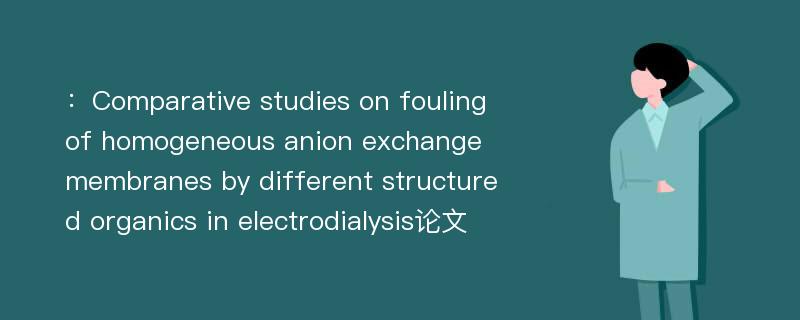
本文主要研究内容
作者(2019)在《Comparative studies on fouling of homogeneous anion exchange membranes by different structured organics in electrodialysis》一文中研究指出:Five negatively charged organic compounds with different structures, sodium methane sulfonate(MS), sodium benzene sulfonate(BS), sodium 6-hydroxynaphthalene-2-sulfonate(NSS), sodium dodecyl sulfate(SDS), and sodium dodecyl benzene sulfonate(SDBS), were used to examine the fouling of an anion exchange membrane(AEM) in electrodialysis(ED),to explore the effect of molecular characteristics on the fouling behavior on the AEM and changes in the surface and electrochemical properties of the AEM. Results indicated that the fouling degree of the AEM by the different organics followed the order:SDBS > SDS > NSS > BS > MS. SDBS and SDS formed a dense fouling layer on the surface of the AEM, which was the main factor in the much more severe membrane fouling, and completely restricted the transmembrane ion migration. The other three organics caused fouling of the AEM by adsorption on the surface and/or accumulation in the interlayer of the AEM, and exhibited almost no influence on the transmembrane ion migration. It was also concluded that the organics with benzene rings caused more severe fouling of the AEM due to the stronger affinity interaction and steric effect between the organics and the AEM compared with organics with aliphatic chains.
Abstract
Five negatively charged organic compounds with different structures, sodium methane sulfonate(MS), sodium benzene sulfonate(BS), sodium 6-hydroxynaphthalene-2-sulfonate(NSS), sodium dodecyl sulfate(SDS), and sodium dodecyl benzene sulfonate(SDBS), were used to examine the fouling of an anion exchange membrane(AEM) in electrodialysis(ED),to explore the effect of molecular characteristics on the fouling behavior on the AEM and changes in the surface and electrochemical properties of the AEM. Results indicated that the fouling degree of the AEM by the different organics followed the order:SDBS > SDS > NSS > BS > MS. SDBS and SDS formed a dense fouling layer on the surface of the AEM, which was the main factor in the much more severe membrane fouling, and completely restricted the transmembrane ion migration. The other three organics caused fouling of the AEM by adsorption on the surface and/or accumulation in the interlayer of the AEM, and exhibited almost no influence on the transmembrane ion migration. It was also concluded that the organics with benzene rings caused more severe fouling of the AEM due to the stronger affinity interaction and steric effect between the organics and the AEM compared with organics with aliphatic chains.
论文参考文献
论文详细介绍
论文作者分别是来自Journal of Environmental Sciences的,发表于刊物Journal of Environmental Sciences2019年03期论文,是一篇关于,Journal of Environmental Sciences2019年03期论文的文章。本文可供学术参考使用,各位学者可以免费参考阅读下载,文章观点不代表本站观点,资料来自Journal of Environmental Sciences2019年03期论文网站,若本站收录的文献无意侵犯了您的著作版权,请联系我们删除。
